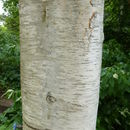More info for the term:
treeGray birch is found on a wide variety of sites. It grows best on moist,
well-drained soil along streams, ponds, lakes, and swamps but also grows
on dry sandy or gravelly soil. Gray birch grows on inorganic soils of
rocky slopes and hillsides, but its growth is usually retarded on these
sites [
6,
8,
17].
Common tree associates of gray birch are blackgum (Nyssa sylvatica),
black oak (Quercus velutina), red oak (Q. borealis), eastern hophornbeam
(Ostrya virginiana), American holly (Ilex opaca), black cherry (Prunus
serotina), flowering dogwood (Cornus florida), and aspen (Populus
tremuloides). Common understory associates include hobblebush (Viburnum
alnifolium), blueberry (Vaccinium spp.), witch hazel (Hamamelis
virginiana), bayberry (Myrica pensylvanica), and Canada serviceberry
(Amelanchier canadensis) [
22,
27,
29,
36].

